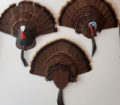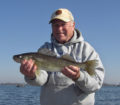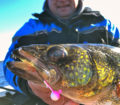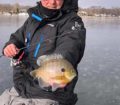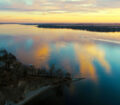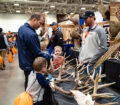By Steve Weisman
This is the time of year that northwest Iowans get excited for the annual spring gill netting by the DNR personnel at the Spirit Lake Hatchery. One of the most amazing things to me is how quickly the northern pike netting goes.
In visiting with Kim Hawkins, Natural Resources Biologist and Spirit Lake Hatchery Manager, the nets were set on March 29 at two different sites: the Hales Slough Trap and Buffalo Run. Nets were run on Monday and Tuesday with the pike spawned out by the end of the day on Tuesday. “Numbers were really good. We caught 84 females and 91 males. We spawned a total of 47 females. These fish produced 36.35 quarts of eggs, which should equate to 875,000 fry.” All fish were returned to the lake on Wednesday.
With the issues with COVID-19, Hawkins says she and the staff have been working on the appropriate amount of social distancing. When two-person teams go out, they each drive their own vehicle to and from the ramp. In the boat, they practice the recommended six-foot social distancing and also wear protective masks.
With the threat of COVID-19, Hawkins could only rely on her fish management and research teams when it came to the walleye gill netting. This meant only one boat would be sent out on East Okoboji and one on Big Spirit Lake each night. That would be a far cry from the 12-14 DNR personnel and 6-7 boats at the height of the netting efforts during normal years. As a result, collection numbers had to be adjusted. Last year 1200 females were captured, while this year the goal was to be 650 females.
Monday, April 6 was the first night, and the hope was that things could be finished by the end of the week. Well, guess what! After Wednesday night’s efforts, 771 females and 226 males had been brought into the Spirit Lake Hatchery! Yup, in three days, the crews blew away the 650-female numbers by 121 fish. Wow! That’s exciting, but it is the way the fish were taken that I find the most interesting.
Out of adversity
According to Mike Hawkins, District Fisheries Biologist, the first night found one boat working the north end of East Okoboji and one boat out in front of Crandall’s Beach on Big Spirit. A total of 167 females came off of East and 99 off of Big Spirit. However, only 6 males were netted on East and 4 males on Big Spirit.
So now what? On Tuesday, the crew went to the raceway (overflow) area between the Big Spirit spillway and the north end of East Okoboji. By using a backpack electro fisher and a net to capture the walleyes that came to the top, workers captured 42 males and 15 females. They also took a boat to the mouth of the lake (at the end of the raceway) and electro shocked the area and caught another 27 males and 13 females. These sampling devices gently stun the fish and are collected unharmed.
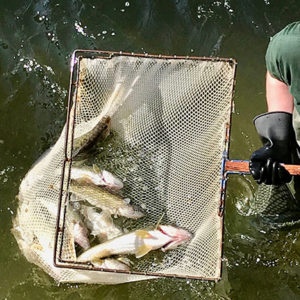
(photo by Steve Weisman) A net full of walleyes taken in the raceway (overflow) area between the Big Spirit spillway and the north end of East Okoboji.
Then on Tuesday night’s gill netting, the boat on East Okoboji captured 104 females and 2 males, while the boat on Big Spirit brought in 112 females and 22 males.
Wednesday brought another trip to the overflow between Big Spirit and East Okoboji and electro shocked 86 males and 35 females. They also checked the mouth of East Okoboji and caught another 27 males and 14 females.
Wednesday night brought another 138 females and 6 males from East Okoboji and 74 females and 4 males from Big Spirit.
Although all of the females have yet to spawn out, estimates show about 665 total quarts, which translates to 92 million eggs. That will result in approximately 55 million fry for stocking.
Finding a way
How about this one? For Ben Wallace, Fisheries Biologist for the Black Hawk Lake Fisheries Management area, spring gill netting has always taken place on Storm Lake. However, with travel restrictions, netting Storm Lake was not an option. That meant that 400 quarts of eggs would not be collected. Out of adversity, however, sometimes comes inventiveness…Necessity is the mother of invention!
With Storm Lake out of the picture, Wallace had to be inventive…his answer was Black Hawk Lake near Lake View. With a good walleye population and a smaller water body that would warm more quickly, Wallace knew that beginning the end of March was the time to run some nets.
So, Wallace, along with Matt Mork, Fisheries Technician and two DNR wildlife and park staff decided to give Black Hawk Lake a try Tuesday and Wednesday (March 31-April 1) and then three more nights (APRIL 6-8) to see what they could find. Their goal was to come up with at least 100 quarts of eggs. Throughout their efforts, the team used masks and kept the required social distancing.
Designing temporary hatchery
Although there was no hatchery, Wallace decided to use the recently built Fish House, which sits on a 40’ x 56’ area platform, and turn it into a temporary hatchery. Located in Town Bay, the inside is lighted with an 8’ x 20’ open area over fishable water. So, after much discussion, Mork took the lead and designed temporary holding pens for netted walleyes that would be kept for a maximum of two days. That would give them enough time to net the fish, collect the eggs, make sure the fish were healthy and then release them to the lake. Since they would only be collecting the eggs and not fertilizing them, there was no need to collect any males.
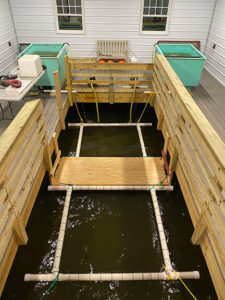
(photo by Ben Wallace) This is the result of the “hatchery” remodeling at the Fish House at Black Hawk Lake.
So, where do you start? Since gillnetting had never taken place on Black Hawk Lake before and Wallace did not know what they might find, the first night Wallace and his crew placed 10 nets around the lake. Wallace says, “I was blown away by what we found. The first night we netted over 230 female walleyes. However, we also had some of the nets filled with all kinds of other gamefish.” That meant a lot of sorting, a time consuming process, when you have to go through 10 nets.
So, the next night Wallace placed four nets at the most productive walleye areas from the night before. “The second night we netted 80 females, but we didn’t have to sort through all of the other species captured.” By the fifth and last night, they knew they were going to surpass their goal, so only two nets were set. Overall, in those five nights, Wallace and his team captured 535 females and collected 140.8 quarts of eggs, which really helped toward filling the lack of gill netting at Storm Lake. The size of the fish was excellent with an average of 21.8” females. The largest netted was a 27-inch female.
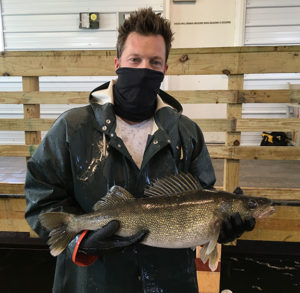
(photo by Ben Wallace) Fisheries Biologist Ben Wallace with a sample of the broodstock taken from Black Hawk Lake.
Two huge jobs well done
What else can you say? A tip of the hat goes out to the crews at the Spirit Lake Hatchery and at Black Hawk Lake! They used ingenuity, knowledge of where the females spawn, persistence and great skill to exceed their quotas. It just goes to show that necessity is the mother of invention!
Thank goodness they were able to put things all together with the way the weather fell apart after Wednesday (April 8). By Sunday, the Easter blizzard had rolled in! Although the results were less than other years, all things considered, this will still allow for ample fry and fingerling stocking to continue.
Over the years, it has become pretty apparent that without these stocking programs, our fisheries would certainly not be the quality that they are. Especially when it comes to walleye fisheries, the annual stocking is the bedrock for northwest Iowa anglers.

